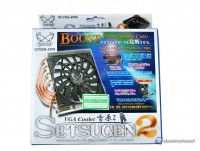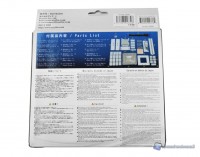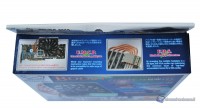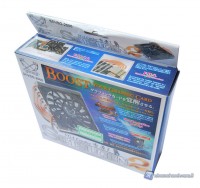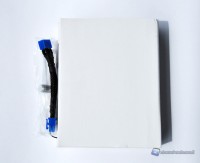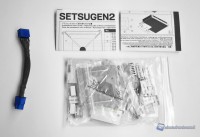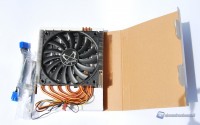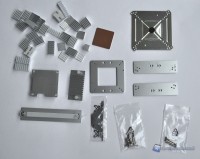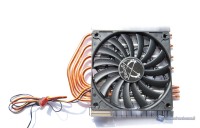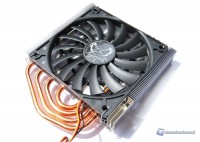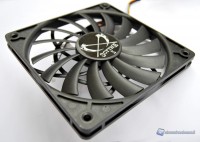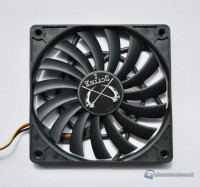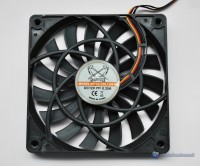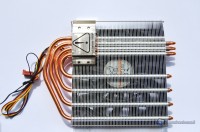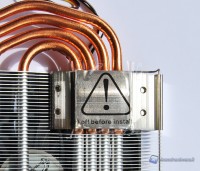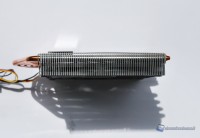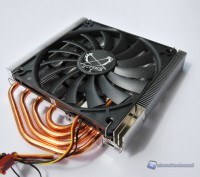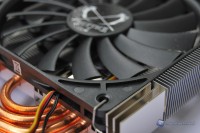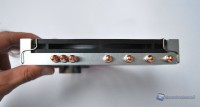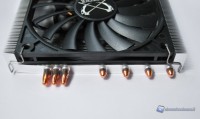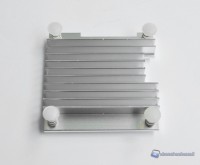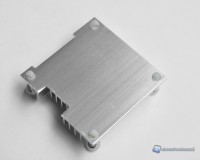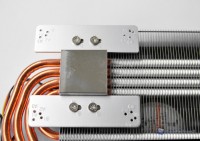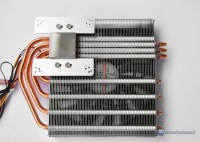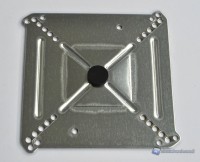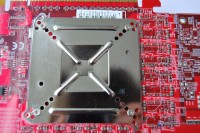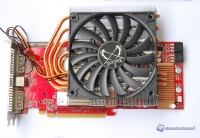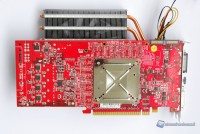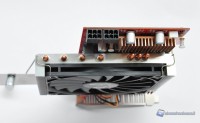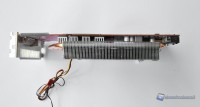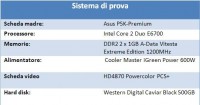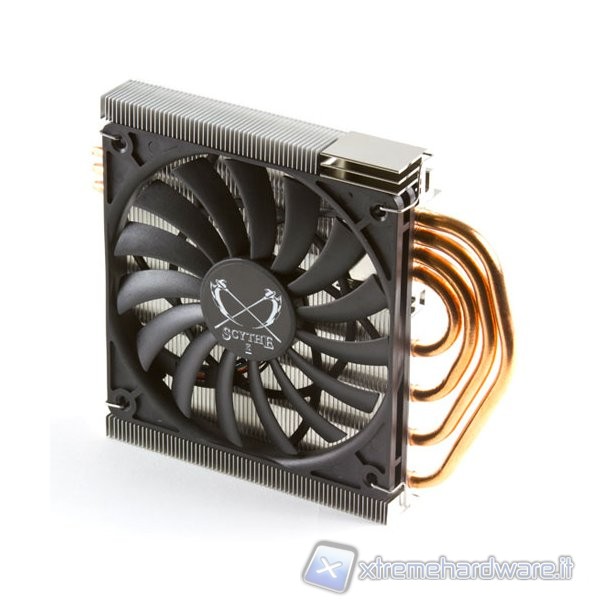
Today we will analyze a video card cooler produced by Scythe: the Setsugen 2. Now in its second revision, the Setsugen is equipped with a 120 mm fan slim type, with the ultimate goal of occupying only one additional slot in addition to the card.We tested it on an HD 4870, comparing it with other coolers in its price range.

Scythe is a company founded in Japan in 2002, it began the production of heat sinks and fans for CPU, originally concentrating in this area.Over the years it has managed to become a leading sink manufacturer in Japan, despite his young age.
Today, it has expanded its range of products, going also in the power supply market, cases and fans with an unbeatable quality/price ratio. It distributes products worldwide and has also factories in America.
The product reviewed today is a video card cooler belonging to the Setsugen series. Unlike Musashi Series, sink with 2 100 mm fans, the Setsugen has a single 120 mm fan.The model that we present in this review is the Setsugen 2 that has a renewed layout over the first generation. The first Setsugen, indeed, featured an internal air extraction fan, with a body detached from the base and connected only through the heat pipes. The new model has a more classic layout, with fan facing the PCB. This made it possible to have a whole dissipating body, however, with the 4 heat pipes arranged in U, so as to improve its efficiency.
Packaging and Bundle
We begin the analysis of Setsugen 2 from the box. Made exclusively in cardboard, the outside has a large number of information and illustrative images of the product and the package contents.On the sides are the technical specifications and compatibility list, not yet updated with the latest models. The information is provided in various languages, mostly Japanese and English.
Just opened the box we find an extension cord for the PCI Express power cable and the potentiometer for adjusting the fan speed. Let's extract an additional housing consisting of two rooms: the first contains the sink itself, already equipped with the fan, while the second contains all the necessary accessories for installation and two instruction manuals in several languages, among which there is not the Italian.
Within an envelope we find all the RAM and VRM heatsinks, mounting brackets, a copper spacer to be placed on the GPU, screws and a packet of thermal paste.
Setsugen 2: first contact
The dissipating body of the Setsugen 2 has a nearly square shape, but thin, which develops around the 120 mm fan.A bold choice indeed by Scythe that differs from the typical rectangular coolers, with two or more fans. As we shall see, the reduced thickness of the heat sink will be a key feature, facilitating use in CrossFire or SLI configurations.
To this end, the installed fan is a Kaze Jyuni Slip Stream Slim characterized by a thickness of only 12 mm, just to reduce the final size of the heatsink.
Let's analyze the dissipating body from the base, in nickel-plated copper. The surface is protected by a transparent film; removing it we can see the decent quality lapping. The base thickness is quite high, the heat pipes are in fact at some distance from the surface of contact with the GPU, to avoid compatibility problems with any components on the surface of the video card. The 4 heat pipes that cross the base are bend in U shape and after a wide curve fall outside of the heat sink and return on the opposite side of the aluminum fins. This allows you to make better use of each heat pipe, which in this way is capable of carrying the heat to two distinct areas of the heat sink. Those in the low side of the sink are in fairly close distance, partially obstructing the flow of air from the fan.
The dissipating body is composed of well 68 aluminum fins, positioned about 1 mm apart. The fan is attached to it by two clips, without the use of rubber grommets to dampen vibrations. The care in the assembly of the Scythe Setsugen 2 still allows you to reduce possible vibrations. The Kaze Jyuni Slim is equipped with well 15 blades, which allow you to get a good flow in spite of the reduced thickness. A directly connected potentiometer allows to adjust the fan speed between 800 and 2000 RPM, allowing you to balance performance and noise level at will. The potentiometer is gauntlet type and can be installed on a PCI Express slot of the case. The fan connector is a standard 3-pin, connected with a classic cable without special coating.
Overall, despite not having special aesthetic devices, the Setsugen 2 has an attractive appearance, mainly due to the excellent workmanship and assembly of its parts.
Setsugen 2: technical specifications
Let's see in detail the specifications of the Scythe Setsugen 2.
- Sink Features:
- Name: Setsugen 2
- Model: SCVSG-2000
- Dimensions: 176x139x33 mm
- Total weight: 435 g
- Number of heat pipes: 4
- Heat pipe diameter: 6 mm
- Fan Features:
- Name: Kaze Jyuni Slip Stream Slim
- Model: SY1212SL12H-V
- Dimensions: 120 x 120 x 12 mm
- Weight: 98 g
- Rotation speed: 800 (± 30%) - 2.000 RPM (± 10%)
- Noise: 19:53 - 33.67 dBA
- Airflow: 19.40 - 45.47 CFM
- MTBF: 30000h
- Bearing Technology: Sleeve Bearing
The lifetime declared for the fan does not seem exceptional, but it seemed well built and, if allowed to operate at temperatures not too high, surely will ensure better longevity.
Below instead there is a list of video cards compatible with the Setsugen 2.
NVIDIA GeForce
- FX5900
- 6600/6800
- 7300/7600/7800/7900
- 8500/8600
- 8800GTS (G92)/8800GT (G92)
- 8800 (G80)
- 9600 GT/GSO 9600/9800 GT/9800 GTX/9800 GTX+
- 250 GTS/GTX 260/GTX 275/GTX 280/GTX 285
- GTX 460/GTX 465/GTX 470
ATI/AMD
- 9***/X***
- X1300/X1600/X1650
- X1800/X1900/X1950
- HD 2600/HD 2900XT
- HD 3650/HD 3850/HD 3870
- HD 4770/HD 4830/HD 4850/HD 4870/HD 4890
- HD 5750/HD 5770/HD 5830/HD 5850/HD 5870
- HD 6950/HD 6970
- HD 6850/HD 6870 (compatible but VRM heatsinks not included for these two cards)
Good the compatibility list, shame about the lack of support to the latest GeForce 5xx.
Assembly
The installation of the Scythe Setsugen 2 was performed on a AMD Radeon HD 4870 produced by PowerColor, used in the past by our editorial team for testing other video card coolers.
Once removed the stock cooler, in this case produced by Zerotherm for PowerColor, we proceeded with cleaning the old thermal paste from the GPU and then the installation, if necessary, of RAM and VRM heatsinks. In our case it was possible to keep most of the existing heatsinks on RAM and VRM.
In other video cards you may need to apply a spacer above the GPU, where the external frame is higher than the GPU itself, or apply heat sinks for specific chips as the GeForce 200 NVIVO or sink equipped with vertical screws for the HD 5800.
Proceeding the installation mounting the bracket to be applied at the base of the heatsink. Depending on the compatibility list of holes in the manual, we will choose one of two brackets. That bracket with frame shape will be used for video cards with lower holes distance, the other, consisting of two separate pieces, will be generally devoted to the latest or higher-end video cards. In our case we installed this bracket using the 4 short screws provided.
Then we applied the thermal paste that comes with the GPU and proceeded with the completion of the installation. We layed the heatsink on the video card, placing the GPU in the lower left of the sink, making sure to check that there is contact between the base and the chip.At this point we proceeded with the application of the backplate by inserting the 4 long screws into the holes specified in the manual.The latter, with a rubber center, will make a slight pressure on the GPU, promoting good contact between the two surfaces.
When assembly is complete, we notice immediately that the heatsink is well above the video card, protruding visibly. So be careful to install this cooler in particularly narrow cases as those for HTPC. We recommend a minimum width of 19 cm.Due to the height of the heatsink may be necessary to use the PCI Express extension cable supplied, if the power cable (too short) should "get over" the video card to reach the power connector. In our case the connectors are positioned sideways so the sink is not a snag in any way.
Another factor to note is that most of the PCBs is not covered, without being invested by the airflow from the fan, this is particularly disadvantageous for the VRM heatsink that, as we shall see from the tests, reach rather high temperatures.
Finally, looking at the video card in profile, we notice that the heatsink Setsugen 2 is confined in the two slots occupied by the HD 4870, permitting the installation of other devices or video cards in adjacent slots. We can not neglect this aspect, which has imposed significant constraints on the cooling system, such as using a slim fan.
System and testing methodology
We tested the cooler on the following system, mounted on a bench, with a temperature of about 25 °C:
We chose to use the HD 4870 video card that, though quite old, can stress the heatsink properly, thanks to its TDP of about 160W.
We measured the temperatures at idle and full load with the RivaTuner software. The temperature at full load were measured after 15 minutes of stress with Furmark, benchmark known for its ability to heavily stress the video card, far more than any video game. We also measured the temperature of the VRM with a digital thermometer with probe.
The temperatures were compared with those of the Powercolor HD4870 PCS+ stock heatsink, an OEM cooler produced by Zerotherm, with the sink Icy Vision Rev 2.0, produced by Gelid Solutions, with the Xigmatek Bifrost and the Spire Slimod II.
As for the stock heatsink, the measurements were performed with fan speed set to minimum (800 rpm) and maximum speed (2000 RPM), using the supplied potentiometer. For the three other coolers we have instead detected temperatures with fan at full speed, or by using a 7V adapter.
Noise
The fan of the stock sink proved to be very noisy at 100% and only tolerable at rotation speeds of less than 40%.
The Scythe Setsugen 2 proved to be quite quiet at full speed and completely inaudible with fan at 800 RPM, similar to that seen with other custom heatsinks used in the comparison, but with different structures (bi-fan).
Test Results
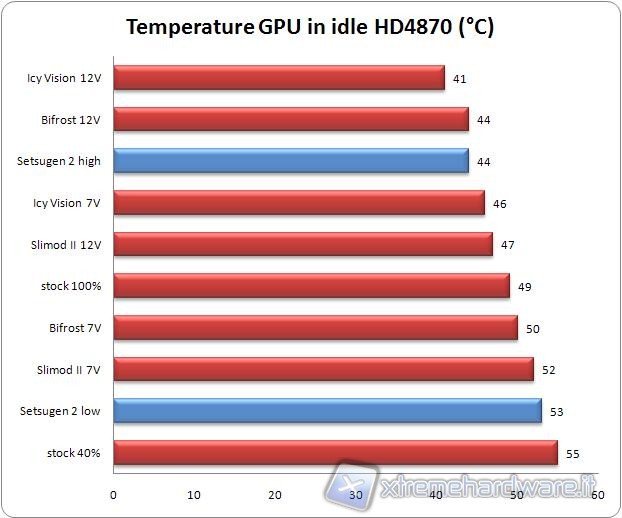
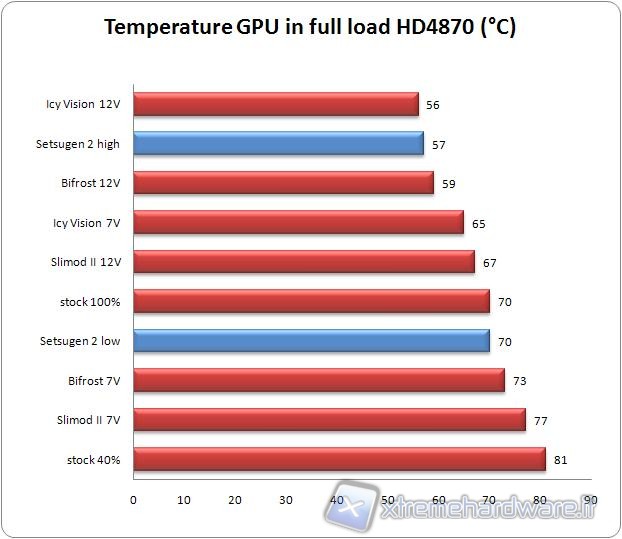
GPU temperatures show a very good behavior of the Scythe Setsugen 2. Idle temperatures are average, with a behavior similar to other heatsinks, possibly penalized by the thickness of the base compared to Direct Contact technology solutions. At full load the Scythe Setsugen 2 shows its full potential. With fan at full speed, temperatures differ from those of Icy Vision Gelid Solutions of just one degree, and with fan at 800 RPM, temperatures rise a bit, but still remain very low and lower than many other solutions with 7V fan.
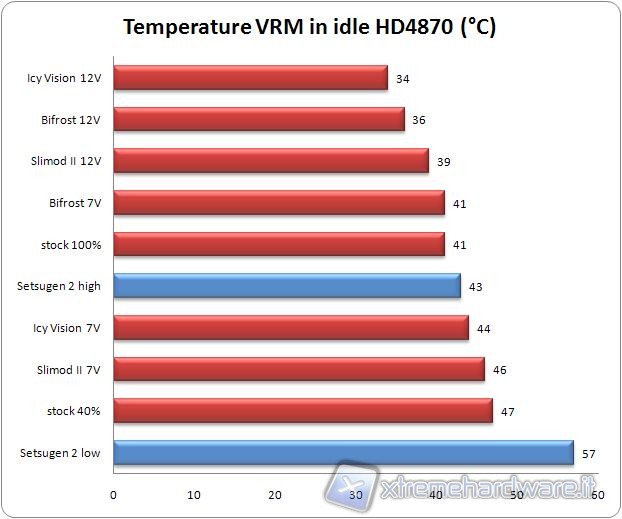
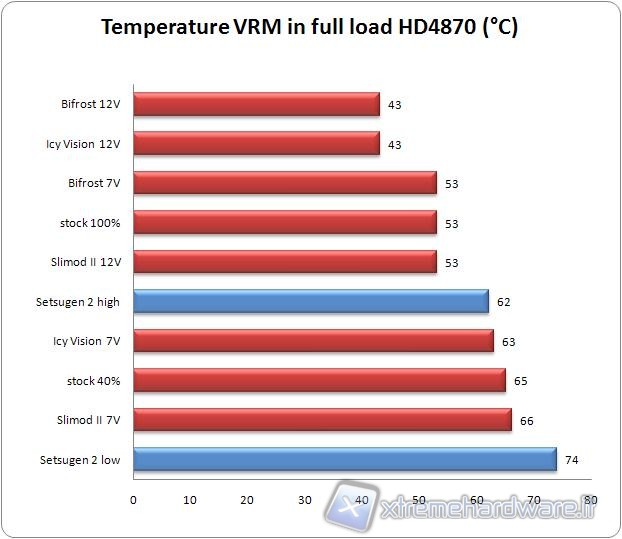
Analyzing the temperature of the VRM we noted a problem that obvously we expected. Because the VRM, positioned on the far left of the card in the HD 4870, remain completely uncovered, without being invested by the flow of heat sink, the temperatures rise easily, and in fact are generally higher than those of other bi-fan solutions.It should be noted, however, that the tests were carried out on a banquet, so no additional ventilation. By installing the video card in a well-ventilated case, surely the VRM temperatures would drop a few degrees. However, except in low RPM configuration, they have never shown concern.
Conclusions

| Performance: | |
| Quality/Price ratio: | |
| Overall: |
The Scythe Setsugen 2 has shown to be a very good heatsink, with very interesting performance. The unconventional single fan structure has not affected the performance, if not in small part with regard to the VRM. Very good the GPU temperatures, both with fan in full speed mode and in silent mode. Really easy to install the potentiometer into a PCI slot to adjust the fan speed at will (and performance in relation to noise). Excellent quality of the cooler, as for Scythe's tradition, especially in relation to the price, which hovers around 40 €.We recommend the purchase of the Setsugen 2 to all those who want to improve the cooling system of your video card, especially the older ones where the stock heatsink soon starts to be noisy and inefficient.
Pros:
- Excellent performance
- Potentiometer
- Thin
- Quality/Price ratio:
Cons:
- Poor dissipation of some video card VRMs
- Thermal paste in bags instead of a tube
We thank Scythe for the product supplied to us for testing.
Leonardo Angelini
Translated by Marco Comerci
